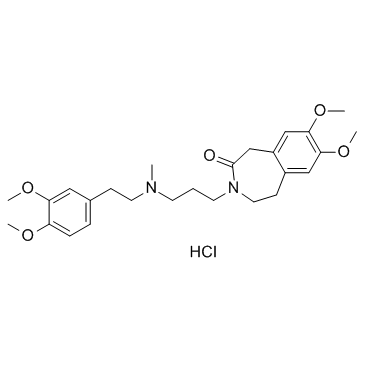Three different bradycardic agents, zatebradine, diltiazem and propranolol, distinctly modify heart rate variability and QT-interval variability.
Motoko Yamabe, Shamarendra N Sanyal, Shinji Miyamoto, Tetsuo Hadama, Shojirou Isomoto, Katsushige Ono
文献索引:Pharmacology 80(4) , 293-303, (2007)
全文:HTML全文
摘要
Zatebradine, diltiazem and propranolol are all antiarrhythmic agents, and all induce bradycardia, but each is known to have a different initial molecular mechanism: zatebradine is a channel blocker of the hyperpolarization-activated inward current (I(f)); diltiazem is a blocker of the L-type Ca(2+) channel (I(CaL)), and propranolol is a beta-blocker. To further investigate the mechanisms underlying their clinical effects, we studied their effects on heart rate variability (HRV) and QT-interval variability (QTV). To this end, guinea pigs were treated with either zatebradine (1.5 mg/kg, i.p.), diltiazem (40 mg/kg, i.p.) or propranolol (20 mg/kg, i.p.). A dose of each agent that decreased HR by 20-22% was used in this study. HRV and QTV were analyzed by a fast Fourier and/or a wavelet transform algorithm. Zatebradine, an I(f) channel blocker, had no significant effect on HRV and QTV. Diltiazem, a non-dihydropyridine I(CaL) blocker, increased high frequency (HF) power and decreased the power ratio of the low frequency (LF) range to the HF range (L/H) in HRV, and increased QTV. Propranolol, a non-selective beta-antagonist, decreased LF power and L/H ratios in HRV, and appreciably reduced QTV. These differences in pharmacological action may help us better understand the antiarrhythmic and/or proarrhythmic actions of these agents when they are used clinically for reducing HR.(c) 2007 S. Karger AG, Basel.
相关化合物
| 结构式 | 名称/CAS号 | 分子式 | 全部文献 |
|---|---|---|---|
 |
盐酸Zatebradine
CAS:91940-87-3 |
C26H37ClN2O5 |
|
Abnormal diastolic currents in ventricular myocytes from spo...
2006-11-01 [Am. J. Physiol. Heart Circ. Physiol. 291(5) , H2192-8, (2006)] |
|
Effects of tachycardia on regional wall motion in acute isch...
2004-06-01 [Tohoku J. Exp. Med. 203(2) , 111-21, (2004)] |
|
Validation of a high-sensitivity assay for zatebradine in dr...
2010-11-01 [Bioanalysis 2(11) , 1863-71, (2010)] |
|
Heart rate reduction by zatebradine reduces infarct size and...
2004-04-01 [Am. J. Physiol. Heart Circ. Physiol. 286(4) , H1281-8, (2004)] |
|
Blocking effects of acehytisine on pacemaker currents (I(f))...
2012-01-06 [J. Ethnopharmacol. 139(1) , 42-51, (2012)] |